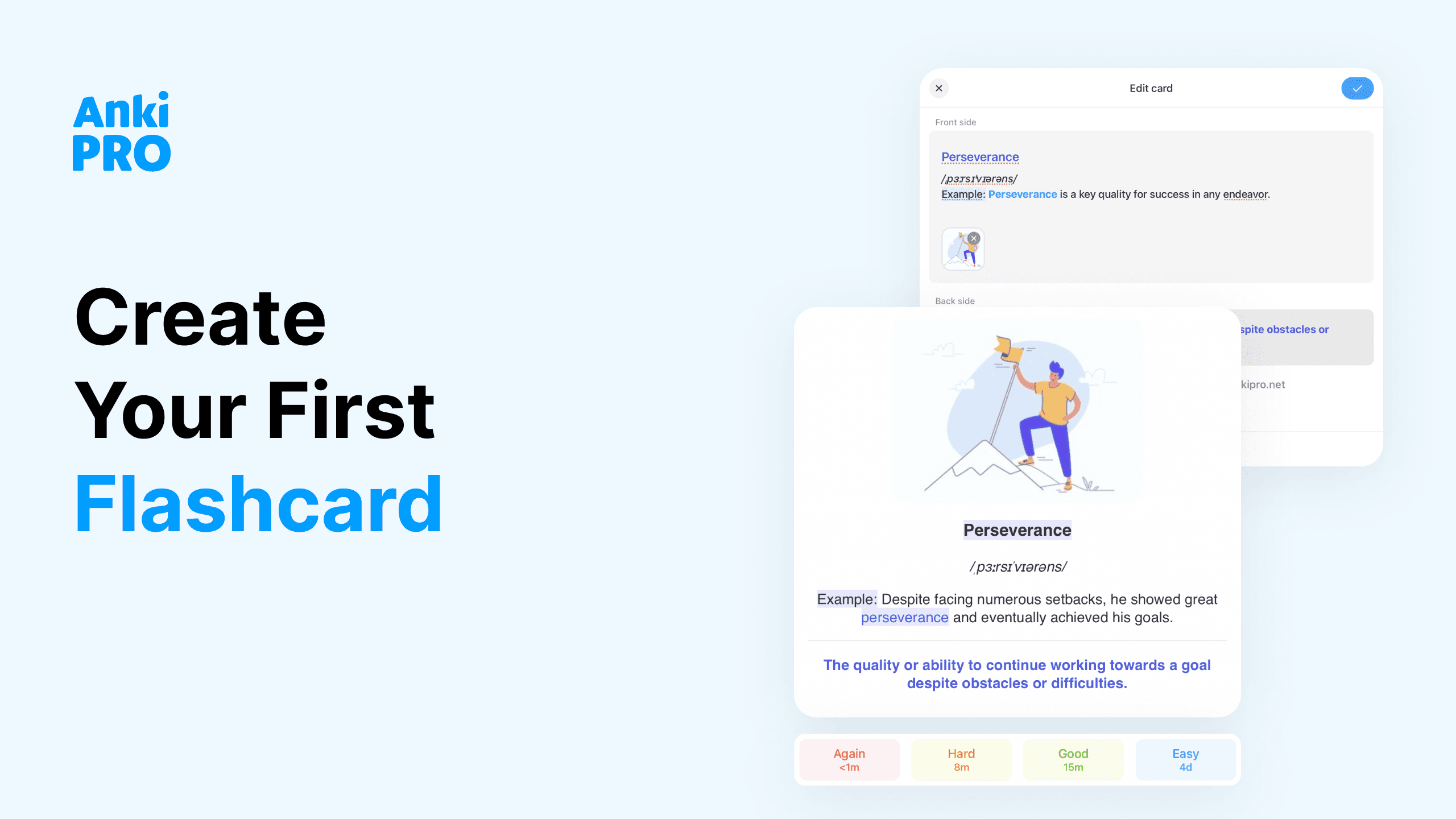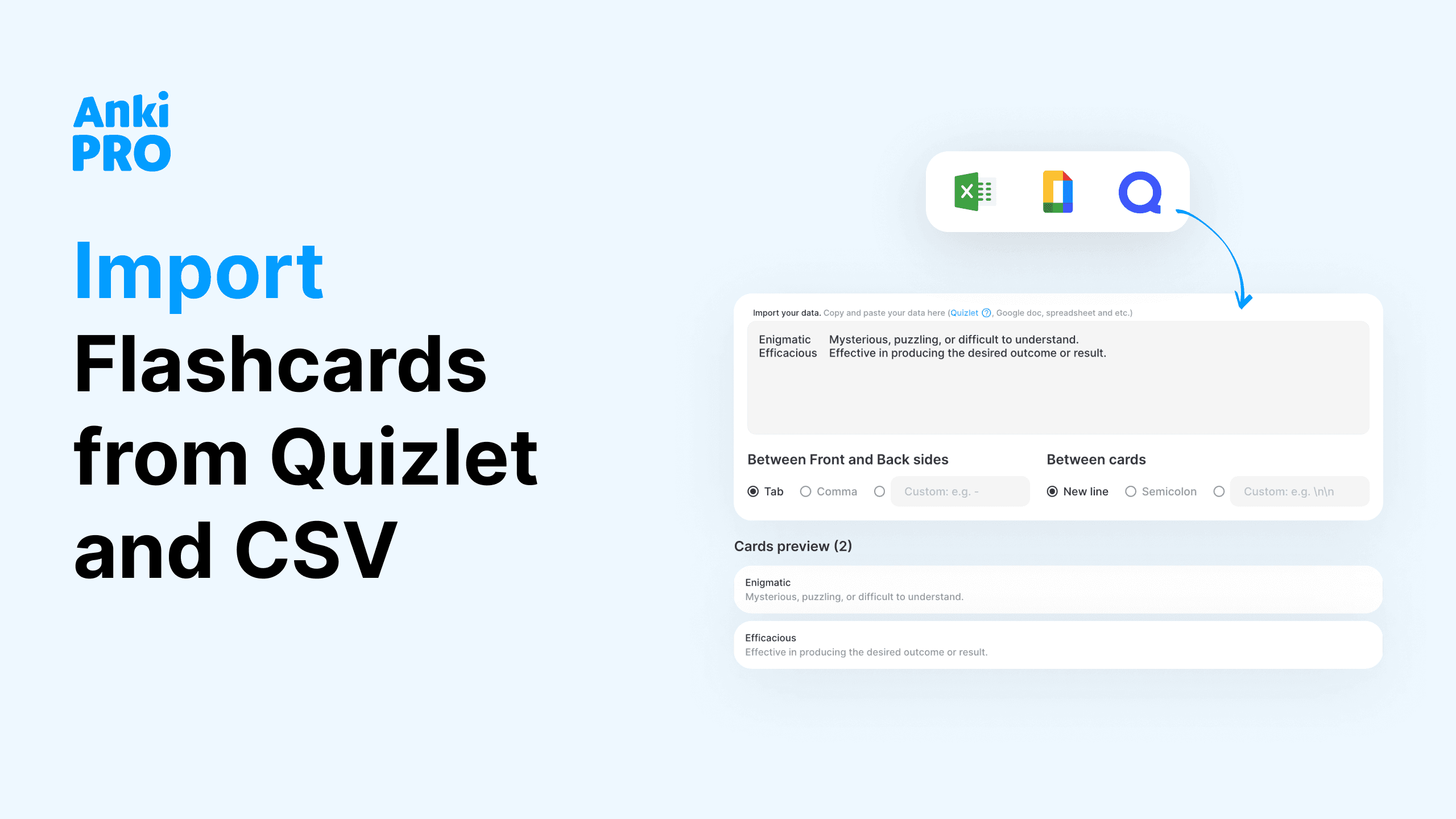Since medical students use Anki Pro religiously, let’s talk MCAT prep, flashcard memorization techniques, and other nuances to consider. How do you optimize your learning to spend less time and memorize more cards?
What Is MCAT?
The Medical College Admissions Test, or MCAT for short, is a standardized exam required to apply for medical school in the United States. The exam has four sections:
- Biological and biochemical foundations
- Chemical and physical foundations of biological systems
- Psychological, social, and biological foundations of behavior
- Critical analysis and reasoning skills
All questions on the exam are multiple-choice.

What Is Anki?
Anki is the Japanese word for “memorization.” It’s also the name of one of the first digital flashcard apps. The original Anki app was a pioneer of spaced repetition at the time but looks a bit dated now. Since then, digital flashcards have come a long way, but some people still use the work Anki for the general concept.
Anki Pro has revolutionized old-school Anki cards for efficiency, ease of use, and ahem much better visuals. Read on to learn how to make the most of your digital flashcards for your MCAT content review.
Benefits of Flashcards for the MCAT
Having an anki phone app makes all the difference. Use Anki Pro is a free flashcard maker to find or create deck collections for any of your needs.
✅ Easy to create and edit flashcards
Efficiency is everything when you’re studying for the MCAT.Writing out paper flashcards is time-consuming. And when you want to change them, you have to make new cards. With Anki Pro and other digital flashcard apps, creating and editing cards is as easy as clicking and typing. Customizable flashcards.
Using pictures on cards can be a huge help for visual learners and those who struggle to stay focused. With paper flashcards, anything beyond words on each side can be more effort than it’s worth. Anki Pro makes it easy to add images, videos, hyperlinks, or audio clips to give your study time multiple sensory inputs and deeper cognitive processing.
✅ Spaced Repetition algorithm
Spaced repetition puts your studying on auto-pilot. Let the algorithm automatically schedule review time based on how old your cards are, how often you’ve reviewed them before, and how many times you’ve gotten them right.
These variable time intervals help you retain information at the same time as you study new material.
✅ Easy to share and collaborate
If you let your friend borrow your physical flashcard deck, you can’t use it at the same time. With an Anki deck, just send other MCAT students the link to your deck and you can both study them.
You can also browse the library of pre-made decks to save yourself the time of making your own.

✅ Progress tracking that works
Typical flashcards don’t come with analytics.Anki Pro can track your progress toward your study goals and let you know what needs more work. You don’t even have to think about it. Studying every day before the exam is the best way to prepare.
Before it becomes a habit, you might need some external motivation to make it happen. Setting notifications to let you know when it’s study time can help you set a routine and stay on track for your goals.
✅ Cloze and Image occlusion features
At Anki Pro, med students feel the safest because they can customize flashcards for their specific, sometimes very specific, needs. The fill-in-the-blank (or Cloze) feature allows you to blank out more than one piece of information on a flashcard creating an equal number of separate cards.
Image occlusion involves covering up parts of an image with boxes so you can test yourself on what’s hidden underneath.
How to Create Effective Flashcards
Anki Pro makes card creation and card review easy. Follow these steps to make the most of this powerful tool for your MCAT preparation.
🧠 Create your own flashcards
Creating your own flashcards is not a waste of time. Sure, it may save time to reuse other people’s decks, but when you create flashcards, you’re also understanding the information in the cards better.
The process of creating a new deck is the first time you review material. As you’re actively typing the material (or writing it if you’re old school), your brain starts to actively remember information.
🧠 Browse the deck library for pre-made decks
Other people who have gotten into medical school have studied the same concepts as you have. Look through their decks and see how they compare to yours. Do they use more visual aids? Do they use more concise questions and answers?
If you find decks that you like better, feel free to use pre-made decks of the ones you created. Maybe you’ll like your own decks for some subjects and other people’s for other subjects.

🧠 Start with the basics
Making new cards can seem daunting before you start it. You don’t have to make all your decks at once. Start by making one deck for a subject that you find easy.
Definitions of terms are usually a good place to start. When you hit your stride, keep making decks for more advanced material.
🧠 Use short answers and questions
Breaking up big definitions into smaller questions makes it easier to memorize information because it engages active recall, the process of actively stimulating your memory to find information. This way, you can more easily apply the information you learn to test day and real-life situations later on.
For example, it would be hard for anyone to memorize a card that says The Krebs Cycle on one side and “The sequence of reactions by which most living cells generate energy during the process of aerobic respiration. It takes place in the mitochondria, consuming oxygen, producing carbon dioxide and water as waste products, and converting ADP to energy-rich ATP..” on the other. Instead, break it down into separate practice questions like:
- Where does the Krebs Cycle take place?
- What does the Krebs Cycle produce?
- What does the Krebs Cycle consume?
- What are the waste products of the Krebs Cycle?
Those could all be questions on their own, or you could combine all of them to answer “what is the Krebs Cycle?”
🧠 Add multimedia features
Visual aids on flashcards are powerful tools. If you’re a visual learner, using pictures and diagrams on your flashcards is a great way to strengthen your understanding and associations.
Diagrams, pictures, charts, pronunciations of terms, and other add-ons can help you retain information for a wide variety of MCAT subjects and facilitate studying.
🧠 Stick to daily reviews
The MCAT exam isn’t a good idea to cram for at the last minute. It’s not helpful at all! A consistent study routine will help you retain all the information.
Set up notifications to remind you to study at a certain time or just trust smart Anki Pro push notifications.

Anki for the MCAT: Study Tips
Creating your decks is just the beginning of your studying journey. These hot tips will make every step of your journey easier.
🤓 Start early
The MCAT isn’t something you can cram for. Experts say the MCAT requires 200 to 300 hours of preparation. Most undergrad students start studying in their junior year, take the exam in the spring, and apply for med schools in their senior year.
🤓 Set study goals
You probably know what score you need to get into your dream school. But how do you plan on getting it? To set actionable study goals, ask yourself questions along the way like: How much material do you want to cover every week? How many hours do you want to study every week? What scores do you want to get on practice exams?
🤓 Understand the information first
Before you make your cards, make sure you analyze passages and understand the information you’re about to put on them. You wouldn’t want a misunderstanding in your notes to get stuck in your brain because you copied it into your deck. If you have any doubts, look it up on an additional source.
🤓 Study on the go
We know students are busy. Taking your flashcards with you and using them during your free time while you’re out and about is smart time management. When they live on an app, they’re not another thing you have to remember to bring with you. With Anki Pro, you can study biology amino acids while waiting for your bus.
🤓 Update cards you get wrong often
Once you create your anki flashcards, they don’t have to stay the same. If you’re frequently getting a card wrong, change it to make it easier to understand. This could mean breaking it up into multiple cards, a shorter answer, picking a different card type, or adding a visual aid.
🤓 Mix up the order
If you review your flashcards in the same order, your brain will associate each answer with the sequence you studied it in. This isn’t good for retaining information long-term. That’s why it’s important to stick to Anki Pro’s spaced repetition algorithm that shows you different cards depending on various factors.
Also, alternate between which side of the card you show first. Showing the answer first about half the time can help you retain information regardless of context.
🤓 Read flashcards out loud
Speaking each question and answer out loud adds sensory input that can help with retention by keeping you actively involved in the learning process. People might look at you funny if you do it in public.
🤓 Integrate flashcards with your other MCAT study materials
Effective study strategies don’t rely on one tool. Use your Anki flashcards alongside the other tools you use to study for the MCAT. Some great ways to do that include:
- Create cards while you read and come across new words and concepts
- Create cards based on the material in prep courses
- Review cards on the way to meet your study group
- Create cards while you review your lecture notes
- Take practice tests and improve your cards based on how you did

Stay Strong and Use Anki Pro 💪
You’re smart. Otherwise, you wouldn’t be doing this. Use methods that have helped you succeed academically in the past and supplement them with your flashcard practice.
Studying for the MCAT isn’t easy, but it doesn’t have to be unnecessarily hard. Now that you know how Anki Pro can help, you have one more tool in your belt to succeed in your preparation journey and beyond.
Download Anki Pro today (for desktop, Apple, and Android devices) to go forth and study!









